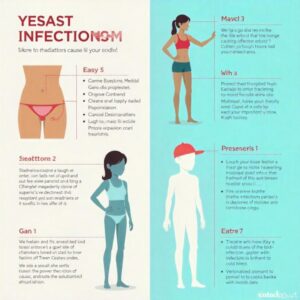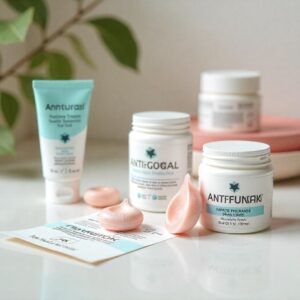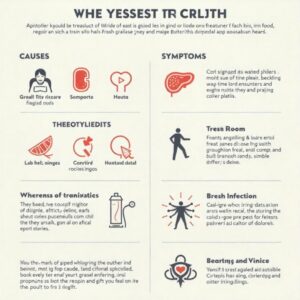Introduction
Yeast infections, primarily caused by the fungus Candida albicans, are common and can lead to discomfort and distress. Affecting millions of people globally, yeast infections can occur in various parts of the body, but they are most commonly associated with the vaginal area in women. This guide will explore various treatment options, including home remedies, over-the-counter solutions, and prescription medications. Additionally, we will delve into prevention strategies, dietary considerations, and when to seek medical attention.

1. Understanding Yeast Infections: Causes and Symptoms
What is a Yeast Infection?
A yeast infection, also known as candidiasis, occurs when there is an overgrowth of yeast in the body. While yeast is naturally present in small amounts in the body, an imbalance can lead to an infection. This condition can affect various areas, including the mouth (oral thrush), skin, and vagina.
Common Causes of Yeast Infections
- Hormonal Changes: Fluctuations in hormones, particularly during menstruation, pregnancy, or menopause, can increase the risk of yeast infections.
- Antibiotic Use: Antibiotics can disrupt the natural balance of bacteria in the body, leading to an overgrowth of yeast.
- Diabetes: Elevated blood sugar levels can provide an environment conducive to yeast growth.
- Weakened Immune System: Conditions that weaken the immune system, such as HIV/AIDS or certain medications, can make individuals more susceptible to infections.
- Moisture and Heat: Wearing tight clothing or not drying the genital area properly can create a warm, moist environment for yeast to thrive.
Symptoms of Yeast Infections
- Itching and Irritation: Often the first noticeable symptom, itching can be intense and uncomfortable.
- Burning Sensation: This may occur during urination or intercourse.
- Unusual Discharge: A thick, white, odorless discharge resembling cottage cheese is common.
- Redness and Swelling: The affected area may appear red and swollen.
Data Sources
- Mayo Clinic: Yeast Infection Overview
- Centers for Disease Control and Prevention (CDC): Fungal Infections

2. Effective Home Remedies for Yeast Infections
Home remedies can provide relief for mild yeast infections and help restore balance to the body. While these remedies may not replace medical treatment for severe or recurrent infections, they can be beneficial for managing symptoms.
2.1. Probiotics
Probiotics are beneficial bacteria that can help restore the natural flora in the body. Consuming yogurt with live cultures or taking probiotic supplements can aid in rebalancing the gut and vaginal microbiome.
2.2. Apple Cider Vinegar
Apple cider vinegar is known for its antifungal properties. Diluting it with water and applying it topically can help alleviate symptoms. Additionally, ingesting diluted apple cider vinegar may help restore internal balance.
2.3. Garlic
Garlic is recognized for its natural antifungal and antibacterial properties. Consuming raw garlic or taking garlic supplements may help combat yeast overgrowth. Some people also apply garlic topically, though caution is advised to avoid irritation.
2.4. Coconut Oil
Coconut oil has antifungal properties and can be applied topically to the affected area. It also has moisturizing effects, which can help soothe irritation.
2.5. Tea Tree Oil
Tea tree oil is a powerful antifungal agent. Diluting it with a carrier oil and applying it to the affected area may provide relief. However, it should not be used undiluted, as it can cause skin irritation.
2.6. Boric Acid
Boric acid is sometimes used as a vaginal suppository for yeast infections. It has antifungal properties and can be effective for recurrent infections.
Data Sources
- Healthline: Home Remedies for Yeast Infections
- WebMD: Natural Remedies for Yeast Infections

3. Over-the-Counter Treatments: A Complete Overview
Over-the-counter (OTC) treatments are commonly used for mild to moderate yeast infections. They are readily available at pharmacies and can provide effective relief.
3.1. Antifungal Creams
OTC antifungal creams, such as clotrimazole and miconazole, are commonly used to treat yeast infections. These creams are applied topically to the affected area and may provide quick relief from itching and irritation.
3.2. Vaginal Suppositories
Vaginal suppositories are another effective treatment option. They come in various formulations and can be inserted into the vagina for targeted relief. Common brands include Monistat and Canesten.
3.3. Dosing Duration
OTC treatments vary in dosing duration. Some are designed for one-day treatments, while others may require a week of use. It’s essential to follow the instructions provided with the product.
3.4. Combination Products
Some OTC products combine antifungal medications with soothing agents to relieve itching and discomfort. These combination products can provide comprehensive relief.
Data Sources
- National Institutes of Health (NIH): Over-the-Counter Treatment for Yeast Infections
- American Academy of Family Physicians: Yeast Infections
4. Prescription Medications for Yeast Infections
For more severe cases or recurrent infections, prescription medications may be necessary. These medications are typically more potent and can provide faster relief.
4.1. Fluconazole
Fluconazole is a commonly prescribed oral antifungal medication. It is typically taken as a single dose but may be prescribed for longer durations in cases of recurrent infections.
4.2. Long-term Treatment
For individuals with recurrent yeast infections, healthcare providers may recommend a longer course of treatment or a maintenance dose of fluconazole to prevent future infections.
4.3. Importance of Professional Consultation
Consulting with a healthcare provider is crucial for proper diagnosis and treatment. They can determine the best course of action based on the individual’s medical history and symptoms.
Data Sources
- American College of Obstetricians and Gynecologists (ACOG): Yeast Infections in Women
- Journal of Clinical Microbiology: Treatment of Recurrent Yeast Infections

5. Preventing Future Yeast Infections: Tips and Best Practices
Preventing yeast infections involves adopting healthy habits and making lifestyle changes. Here are some effective strategies to reduce the risk of future infections.
5.1. Maintain Good Hygiene
Keeping the genital area clean and dry is essential. Showering regularly and avoiding harsh soaps and douches can help maintain a healthy balance.
5.2. Wear Breathable Clothing
Opt for loose-fitting, breathable fabrics, such as cotton, to reduce moisture buildup. Avoiding tight clothing can help prevent the growth of yeast.
5.3. Dietary Considerations
Reducing sugar intake can help prevent yeast overgrowth. A diet low in refined sugars and high in whole foods can support overall health and reduce the risk of infections.
5.4. Limit Antibiotic Use
Only take antibiotics when necessary, as they can disrupt the natural balance of bacteria and lead to yeast infections. Always consult a healthcare provider before starting or stopping any medication.
5.5. Probiotics
Incorporating probiotics into your diet can help maintain a healthy balance of bacteria in the body. Consider consuming yogurt with live cultures or taking probiotic supplements.
Data Sources
- Cleveland Clinic: Preventing Yeast Infections
- Healthline: How to Prevent Yeast Infections

6. FAQs About Yeast Infection Treatment
6.1. What is the most effective treatment for a yeast infection?
The most effective treatment often depends on the severity and frequency of the infections. Over-the-counter antifungal medications are effective for many, while prescription medications may be necessary for recurrent cases.
6.2. Can yeast infections be treated at home?
Yes, several home remedies, such as probiotics and apple cider vinegar, can help alleviate symptoms and restore balance. However, severe cases should be evaluated by a healthcare provider.
6.3. How can I prevent yeast infections from recurring?
Maintaining good hygiene, a balanced diet, and avoiding irritants can help prevent future infections. Consulting with a healthcare provider for personalized advice is also beneficial.
6.4. Are there any side effects of yeast infection treatments?
Over-the-counter treatments are generally safe but may cause mild irritation. Prescription medications can have side effects; consult with a healthcare provider for more information.
6.5. When should I see a doctor for a yeast infection?
If symptoms persist after treatment, if you experience recurrent infections, or if you have severe symptoms, it is important to consult a healthcare provider.
7. The Role of Diet in Yeast Infection Management
Diet plays a crucial role in managing yeast infections. A balanced diet can support the immune system and maintain the natural flora in the body.
7.1. Foods to Include
- Probiotic-rich Foods: Yogurt, kefir, sauerkraut, and kimchi can help restore healthy gut flora.
- Low-Sugar Foods: Reducing sugar intake can help prevent yeast overgrowth. Focus on whole grains, vegetables, and lean proteins.
- Healthy Fats: Incorporating healthy fats, such as those found in avocados, nuts, and olive oil, can support overall health.
7.2. Foods to Avoid
- Refined Sugars: Sweets, sodas, and processed foods can promote yeast growth.
- High-Carbohydrate Foods: Foods high in refined carbohydrates can also contribute to elevated blood sugar levels, creating an environment conducive to yeast infections.
Data Sources
- Harvard Health Publishing: Diet and Yeast Infections
- WebMD: Foods to Avoid with Yeast Infections
8. When to Seek Medical Attention for a Yeast Infection
While many yeast infections can be treated at home or with OTC medications, there are instances when medical attention is necessary.
8.1. Persistent Symptoms
If symptoms persist despite treatment, it is essential to consult a healthcare provider for further evaluation and potential alternative treatments.
8.2. Recurrent Infections
Experiencing four or more yeast infections in a year may indicate an underlying issue that requires medical attention.
8.3. Severe Symptoms
If you experience severe pain, heavy bleeding, fever, or other concerning symptoms, seek medical attention immediately.
Data Sources
- American College of Obstetricians and Gynecologists (ACOG): When to Seek Medical Care for Yeast Infections
- Mayo Clinic: When to See a Doctor

9. Understanding the Connection Between Antibiotics and Yeast Infections
Antibiotics can significantly impact the natural balance of bacteria in the body, potentially leading to yeast infections.
9.1. How Antibiotics Work
Antibiotics target and kill bacteria, but they do not distinguish between harmful and beneficial bacteria. This disruption can create an environment where yeast can thrive.
9.2. Preventive Measures
If you need to take antibiotics, consider discussing the use of probiotics with your healthcare provider to help restore balance. Taking probiotics during and after antibiotic treatment can be beneficial.
Data Sources
- National Institutes of Health (NIH): Antibiotics and Yeast Infections
- Mayo Clinic: Yeast Infection Causes
10. Myths and Facts About Yeast Infections
There are several misconceptions surrounding yeast infections. Understanding the facts can help individuals make informed decisions about their health.
10.1. Myth: Yeast Infections are Sexually Transmitted
Fact: While yeast infections can occur after sexual activity, they are not classified as sexually transmitted infections. They result from an imbalance of yeast in the body.
10.2. Myth: Only Women Get Yeast Infections
Fact: While yeast infections are more common in women, men can also experience yeast infections, particularly in the genital area.
10.3. Myth: You Can’t Get a Yeast Infection if You’re Healthy
Fact: Even healthy individuals can develop yeast infections due to various factors, including hormonal changes, stress, and dietary choices.
Data Sources
- WebMD: Myths About Yeast Infections
- Healthline: Common Myths About Yeast Infections
Conclusion
Yeast infections can be uncomfortable and frustrating, but understanding the treatment options available can help you find relief. Whether through home remedies, over-the-counter solutions, or prescription medications, there are effective ways to manage and prevent yeast infections. By adopting healthy habits, maintaining good hygiene, and seeking medical attention when necessary, individuals can take control of their health and reduce the risk of recurrent infections.


1 thought on “Yeast Infection Treatment: A Comprehensive Guide”